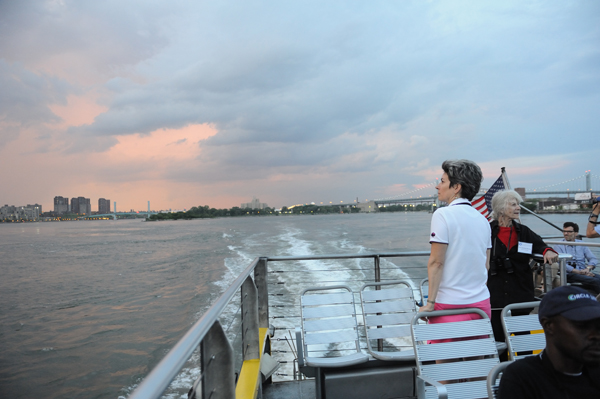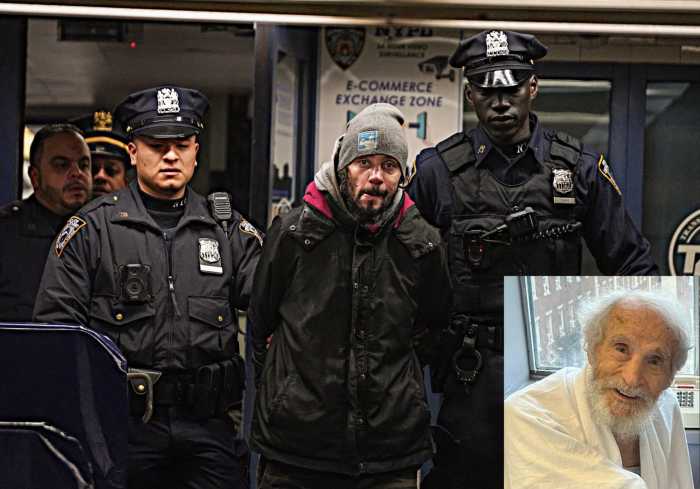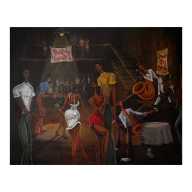
BY TERESE LOEB KREUZER | [Posted July 18, 2013] New York City Audubon Society guide Gabriel Willow has stories to tell about the diverse wildlife that lives in New York City alongside the city’s approximately eight million humans. For 10 years, summer and winter, he has been telling these stories aboard New York Water Taxi vessels, which tour the harbor on what are billed as “ecocruises.”
This year, each of the three summer ecocruise routes also shows what Superstorm Sandy did to the landscape.
As the boats leave Pier 17 in the South Street Seaport where the cruises originate, Willow begins by conjuring up the glaciers that came down from the Arctic four times over tens of thousands of years, carving out New York City’s islands and estuaries and leaving behind a ridge on Long Island where the glaciers finally stopped and began to retreat. The Hudson River, he tells his passengers, is a deep canyon — really a fjord — that was filled in as the glaciers melted. The East River is not a river at all but a salt water tidal strait connecting Long Island Sound and Upper New York Bay.
In terms of biodiversity, a tidal estuary like the East River is “the second richest landscape in the world,” he says, second only to tropical rain forests. Many kinds of water birds love it.
In summer, the ecocruises go north on the East River to the Brother Islands, which are situated between the Bronx and Riker’s Island. On the way, they pass tiny, man-made U Thant Island, where double-crested cormorants nest by the hundreds. They dive for fish and can hold their breath under water for a minute and a half, says Willow. He points out that they have no oil on their feathers, and have to spread their wings to dry out when they emerge from a dive.
Herons and egrets, who live a little further north on the East River on Mill Rock and South Brother Island, stalk their prey in shallow water and have to travel for their dinner. They go to Jamaica Bay or to the New Jersey wetlands to get food, Willow says.
Mill Rock, a small island near East 96th Street, had a mill on it in the early 18th century and a fortification during the War of 1812. Now it is home to black-crowned night herons, great egrets, snowy egrets, several species of gulls and cormorants.
The great egrets are dazzling in their white plumage, especially when they fly. They and the snowy egrets were hunted almost to extinction for their plumes in the early 20th century, but after protective legislation was enacted, they have returned.
At North Brother Island, Willow tells the story of Typhoid Mary — Mary Mallon was her name — a cook and carrier of the deadly typhoid fever disease, though she never contracted it herself. After infecting numerous people, she was quarantined on North Brother Island from 1915 until 1938, when she died.
The ruins of Riverside Hospital, where Mary was housed, remain on North Brother Island, but after Sandy, they are in more calamitous shape than ever, and more exposed. Vegetation and shoreline were washed away.
A second Audubon ecocruise that goes south from Pier 17 to Hoffman and Swinburne Islands, just beyond the Verrazano-Narrows Bridge, reveals a similar story. These manmade islands were constructed in the 1870s to quarantine immigrants arriving by ocean liner. Swinburne was used for this purpose until the 1920s and still had ruined buildings that Sandy all but demolished. But a large number of double-crested cormorants still favor it as their nesting place.
This summer, the Audubon Society has added a third ecocruise to its roster. This one goes to the Jamaica Bay Wildlife Refuge — part of Gateway National Recreation Area. More than 330 bird species have been sighted there.
As the boat speeds past Coney Island, the city drops away. There are vast expanses of water bordered by mud flats and salt marshes populated with great and snowy egrets, stalking their prey at water’s edge. Oystercatchers with bright red bills and pink legs prowl the beaches. Overhead, common terns dart around the boat interspersed with least terns — a threatened species — rapidly flapping their dainty wings. There are cormorants and four kinds of gulls (ring-billed, herring, great black-backed and laughing gulls, which are small and have solid, black heads). Exotic-looking glossy ibises fly by in the distance. Ospreys sit on their nests. With luck, a peregrine falcon — the fastest creature on Earth — may be spotted. They nest atop New York City’s bridges and feast on pigeons. There may even be a sighting of a bald eagle.
On this trip, some of the communities that bore the brunt of Sandy are sadly evident. The boat passes Seagate, Coney Island, Breezy Point and the Rockaways, where many of the houses still have plywood on their windows and where roofs have caved in completely or are missing shingles.
Some of these houses have American flags flying in front and on one of them, all but destroyed, someone had painted a flag. Toward nightfall, as the boat heads back to Manhattan, it passes Coney Island again. Except in the boardwalk area around the parachute jump and the Wonder Wheel, few lights are on.
This entire area was once a collection of wetlands, tidal marshlands, bays, inlets, creeks and barrier islands. People filled them in and built on them. Now, what was there is reasserting itself. Much of the flooding and damage from Sandy came not only from the storm surge but from water that rose up from historic creeks and marshlands that had been paved over decades ago.
New York City planners realize that marshes, wetlands and beaches are essential for protecting the city from future storms. In the Jamaica Bay Wildlife Refuge, some of this terrain still exists. It’s worth seeing.
The next Jamaica Bay tour is on August 11. On July 28, the Audubon ecocruise goes to Hoffman and Swinburne Islands, and on August 4, to the Brother Islands. For more information or to purchase tickets, go to www.nywatertaxi.com.
































